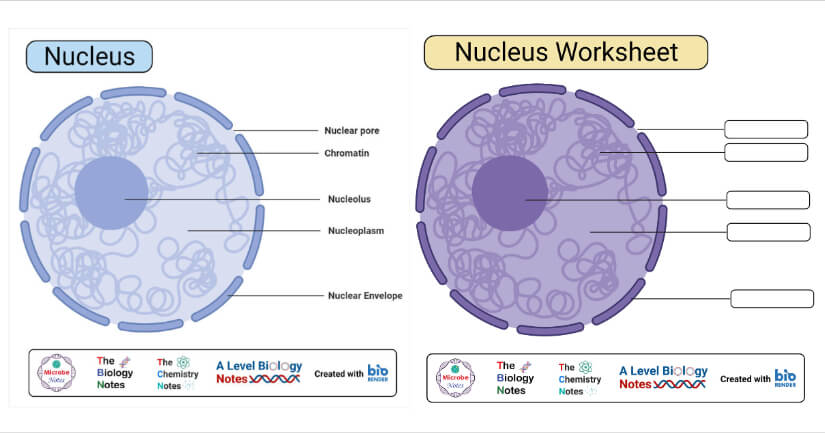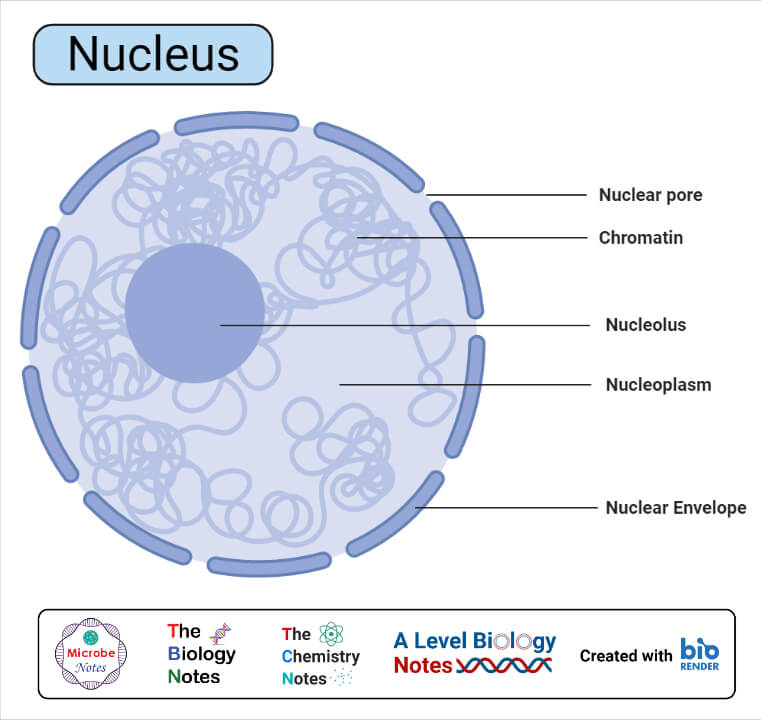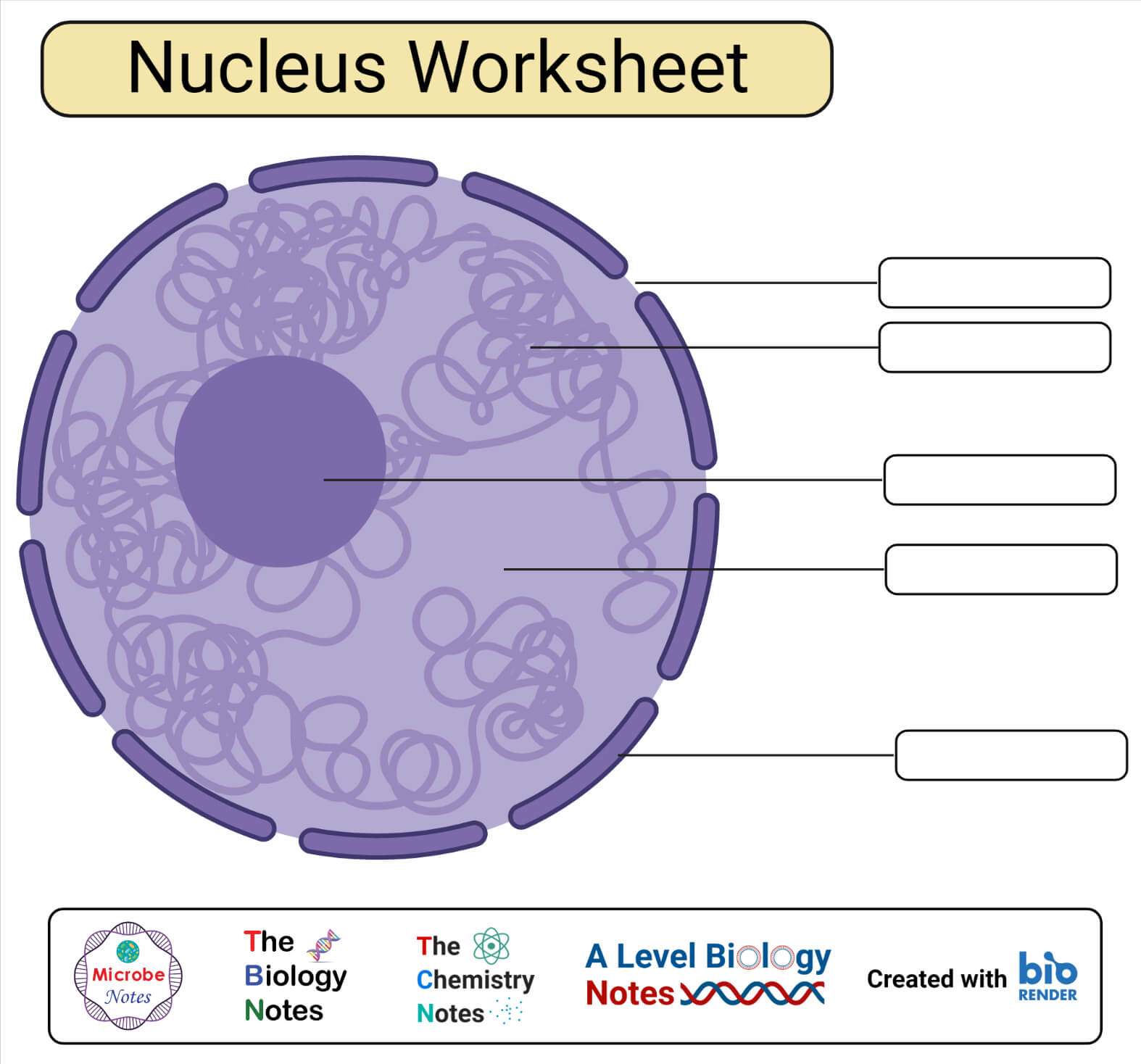- The Nucleus is an important cell organelle that is present in the eukaryotic cell.
- It is derived from the Latin word, ‘nucleus’ or ‘ nuculeus’. It means kernel or seed.
- It is first described by Robert Brown as the cell organelle.
- It was named chromatin by the Flemming.
- It is double-membraned.
- It consists of genetic material.
- The presence of a nucleus is one of the distinguishing features of the eukaryotic cell.
- All the cellular activities are directed and coordinated by the nucleus.
- In the prokaryotic cell, the true nucleus is absent.
- In the case of a eukaryotic cell, the nucleus is present in all cells except the Red Blood Cell (RBC) and sieve tube cell (phloem).
- In the different types of cells, there is a different number of the nucleus.
- Most of the cells consist of only one type of nucleus i.e uninucleated while some of them consist of two nuclei i.e binucleate.
- The multinucleated cell consists of two or more nuclei. Example: slime mold.
- The size of the nucleus is 5-25 µm. So, it is considered to be the largest organelles.
- It occupies about 8% of the total cell volume.
- There is a variation in the shape as well as the position too.
- The nucleus is of different shapes like round, oval, elliptical, or lobed.
- The Nucleus is present in a different position.
- In the animal cell, it is present in the center.
- 在植物细胞中,它存在于边缘。It is because in the center there is the presence of a large water-filled vacuole.

Structure of Nucleus
The structure of the nucleus consists of the following parts. They are:
Nuclear envelope
- It is of the double- membrane and surrounds the nucleus.
- Outer and inner membrane are present in it. The outer membrane of the nucleus is continuous with the ER ( Endoplasmic reticulum ). On its outer surface, there is the presence of many ribosomes.
- Perinuclear space is present between the membranes.
- It is impermeable to large molecules like proteins and RNA.
- Small molecules and ions can move freely.
- Nuclear pores are present in the nuclear envelope. These pores are the small gaps present in the envelope.
- Chemical composition: lipo-proteinous
The function of the nuclear envelope
- It gives the shape to the nucleus.
- It protects the internal constituents of the nucleus.
- It controls and regulates the movement of the substances which enter and exits the nucleus.
Nucleolus
- During the cell division, it disappears in the late prophase.
- In the Telophase stage, it reappears.
- 核仁的结构包括三个main regions. They are :
- Fibrillar centers: In the form of partly condensed chromatin, ribosomal RiboNucleic Acids (rRNA) genes are present.
- Fibrillar component: It surrounds the fibrillar centers where RNA molecules are present.
- Granular regions: It consists of the mature ribosomal precursor particles. These are the outermost regions.
- In the nucleus, the nucleolus may be present 1 to 4 in number.
- It is rounded in structure and naked.
- It is dense and is stained dark in color.
- Chemical composition: RNA and protein
Functions of the Nucleolus
- RNA is synthesized and stored in it.
- Sub-units of ribosomes are formed.
- During the cell division, it forms the spindle.

Other nuclear bodies
Different types of nuclear bodies are present in the nucleus. They are:
- Cajal bodies
- Gemini of Cajal bodies
- PIKA ( Polymorphic interphase karyosomal association)
- PML ( Promyelocytic leukemia) bodies
- Paraspeckles
- Splicing speckles
Chromatin reticulum
- Inside the nucleus, there is the presence of chromatins.
- During the cell division, it is condensed in the chromosome.
- It is dense in structure and is thread-like.
- It consists of proteins and DNA.
- Chromosome remains in the form of chromatin fibers at the interphase stage of cell division.
- They are differentiated into two distinct regions as heterochromatin and euchromatin.
Comparison between heterochromatin and euchromatin can be done based on the following properties:
- Stain: Heterochromatin is dark stained and euchromatin is a lightly stained region of chromatin reticulum.
- Condensation:Heterochromatin is highly condensed and euchromatin is a less condensed region.
- Proportion:Heterochromatin forms the small part whereas euchromatin forms the major part of the chromatin reticulum.
- Activeness:Heterochromatin is genetically inactive and euchromatin is genetically active.
Chromosome
- In 1888 A.D Waldaye gave the term chromosome.
- Chromosome consists of the gene and genes consist of the DNA.
- All the genetic information, heredity characters are present in it.
- A Chromosome consists of the following parts which are revealed by the electron microscope. They are:
- Chromonemata: It is known as the subchromatid. There are two subunits. Chromatids are the two subunits of the metaphasic chromosome.
- Centromere:In the different chromosomes, there is the presence of the constricted regions in different places. Based on the positions they are categorized as metacentric, submetacentric, acrocentric, telocentric chromosomes.
Metacentric chromosome:Centromere is present in the middle and it forms two equal arms of a chromosome.
Sub-metacentricchromosome:Centromere is present nearer to one end of the chromosome due to which resulting arms are unequal. One is a long arm while another is a shorter arm.
Acrocentric chromosome: Centromere is present close to the end. It also results in unequal arms of a chromosome. One will be very short whereas one will be a very long arm.
Telocentric chromosome:It has got a terminal centromere.
Nuclear organizer (secondary constriction I)
- A Nuclear organizer is a constriction that is present near one end of the chromosome. It is necessary for the formation of the nucleolus.
- One or more secondary constrictions may be present.
Satellite:It is very short like the sphere. It is present beyond the nucleolar organizer. It is the non-staining secondary constriction and is the small fragment. It is present only in a few chromosomes.
Telomeres:It is the tip of the chromosome. It prevents the ends of the chromosome from sticking together.
Nuclear matrix
- It is also called a nuclear scaffold.
- With the use of non-ionic detergents, nucleases, and high salt buffers, extraction of the nuclear matrix from the cell’s nucleus is possible.
- It consists of the nuclear lamina which is a network of intermediate filaments.
- It consists of lamin proteins.
- It consists of the nuclear matrix which provides t mechanical support to the nucleus. It acts like the cytoskeleton.
- A Nuclear matrix is a network of fibers and filaments.
Nucleoplasm
- Nucleoplasm is a clear and transparent, gelatinous substance.
- It is also known as the karyoplasm.
- It surrounds the nucleolus and chromosomes.
- It consists of water, minerals, sugar, protein, nucleotides, enzymes, and RNA.
- Nucleoplasm is a semifluid substance.
Function of nucleoplasm
- It forms the spindle proteins which aids in cell division.
- It protects the contents of the nucleus.
- It provides the medium by which the enzymes and nucleotides get transported throughout the nucleus.
- RNA and DNA are synthesized in it.
- Nucleolus and chromatin reticulum are held by nucleoplasm.
- It provides support by acting as the nuclear skeleton.
Nucleus Structure Free Worksheet

Functions of the Nucleus
Storing genetic material
- Genetic material like DNA is stored in the nucleus.
- It is the cellular hereditary material.
- The information which is encoded in the DNA is passed to the offsprings from the parents.
DNA replication
- Replication is the process of copying the parental DNA.
- It occurs in the cell nucleus.
- It takes place in the S phase of the interphase of the cell cycle.
Transcription
- It provides the site for genetic transcription.
- It allows the level of gene regulation which are not available to prokaryotes. It consists of a variety of proteins.
- It either mediates the transcription process directly or is they may be involved in regulating the process.
- Different proteins involved in it are helicases,RNA polymerases, topoisomerases, etc.
Other functions
- The nucleus controls the gene expression and helps in the replication of DNA during the cell cycle.
- Coordinates and regulates cellular activities like cell division, protein synthesis, and growth.
- 核糖体的形成发生在核仁.
- Through the nuclear pores only selective transportation is allowed.
- Organic evolution: It involves variation and can induce genetic change.
- Nucleolus stores the proteins and RNA.
- In the nucleus, during the cell division, chromatins are arranged into chromosomes.
References and Sources
- 1% – https://www.yourarticlelibrary.com/zoology/cell/chromosomes-morphology-structure-heteropycnosis-and-other-details/30661
- 1% – https://www.biologydiscussion.com/essay/essay-on-dna-replication-genetics/37966
- 1% – //www.kirikcitarim.com/detailed-description-of-eukaryotic-nucleus/
- 1% – https://link.springer.com/referenceworkentry/10.1007/3-540-30683-8_1221
- <1% – https://www.toppr.com/ask/question/what-is-centromere-how-does-the-position-of-centrome-form/
- <1% – https://www.thoughtco.com/the-cell-nucleus-373362
- <1% – https://www.thoughtco.com/dna-replication-3981005
- <1% – https://www.frontiersin.org/articles/10.3389/fpls.2014.00166/full
- <1% – https://www.frontiersin.org/articles/10.3389/fmicb.2019.02056/full
- <1% – https://www.differencebetween.com/difference-between-metacentric-and-vs-submetacentric-chromosomes/
- <1% – https://www.britannica.com/science/nucleus-biology
- <1% – https://quizlet.com/338427013/genetics-exam-iii-flash-cards/
- <1% – https://pediaa.com/what-is-the-difference-between-nuclear-membrane-and-nuclear-envelope/
- <1% – https://micro.magnet.fsu.edu/cells/nucleus/nucleus.html
- <1% – https://en.wikipedia.org/wiki/Nuclear_proteins
- <1% – https://en.wikipedia.org/wiki/Nuclear_pore
- <1% – https://en.wikipedia.org/wiki/Euchromatin
- <1% – https://byjus.com/biology/plant-cell/
- <1% – https://biologywise.com/chloroplast-structure-function
- <1% – https://biologywise.com/cell-nucleus-structure-functions
- <1% – https://biologywise.com/cell-nucleus
- <1% – https://biologyeducare.com/chromosome/
- <1% – https://amedleyofpotpourri.blogspot.com/search?updated-max=2018-11-10T07:02:00-08:00&max-results=10&reverse-paginate=true

